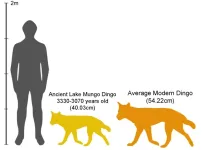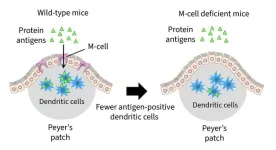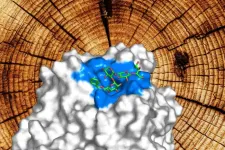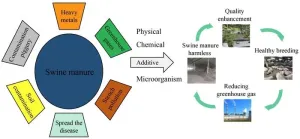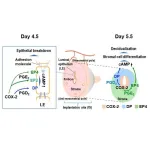(Press-News.org) UPTON, N.Y. — Scientists from the U.S. Department of Energy’s (DOE) Brookhaven National Laboratory have shown that a type of qubit whose architecture is more amenable to mass production can perform comparably to qubits currently dominating the field. With a series of mathematical analyses, the scientists have provided a roadmap for simpler qubit fabrication that enables robust and reliable manufacturing of these quantum computer building blocks.
This research was conducted as part of the Co-design Center for Quantum Advantage (C2QA), a DOE National Quantum Information Science Research Center led by Brookhaven Lab, and it builds upon years of scientific collaboration focused on improving qubit performance for scalable quantum computers. Recently, scientists have been working to increase the amount of time qubits retain quantum information, a property known as coherence that is closely linked to the quality of a qubit’s junction.
They have been particularly focused on superconducting qubits whose architecture includes two superconducting layers separated by an insulator. This part of the qubit is known as an SIS junction, for superconductor-insulator-superconductor. But reliable manufacturing of such sandwich-like junctions is not easy, especially at the precision needed for the large-scale production of quantum computers.
“Making SIS junctions is truly an art,” said Charles Black, co-author of the paper that recently published in the Physical Review A and director of the Center for Functional Nanomaterials (CFN), a DOE Office of Science user facility at Brookhaven Lab.
Black and Mingzhao Liu, senior scientist at CFN and lead author on the paper, have been part of C2QA since its inception in 2020. And while they’ve been helping quantum scientists understand the materials science of qubits to improve their coherence, they’ve also grown curious about the scalability of this qubit-building art and its compatibility with the inevitable need for manufacturing large-scale quantum computers.
So, the scientists turned their attention to qubit architectures with superconducting junctions comprised of two layers connected by a thin superconducting wire, instead of a middle insulating layer. Known as a constriction junction, this architecture lays flat rather than stacking like a sandwich. And importantly, the process for fabricating constriction junctions is compatible with standard methods in semiconductor manufacturing facilities.
“In our work, we investigated the impact of this architectural change,” said Black. “Our goal was to understand the performance tradeoffs of making the switch to constriction junctions.”
Overcoming the increased current flow and linearity
The most prevalent superconducting qubit architecture works best when the junction connecting the two superconductors transmits only a little bit of current. Though the insulator in the SIS sandwich prevents nearly all current transmission, it is thin enough to allow a small amount via a mechanism known as quantum tunneling.
“The SIS architecture is ideal for today’s superconducting qubits, even though it’s tricky to manufacture,” said Black. “But it’s a little counterintuitive to replace the SIS with a constriction, which intrinsically conducts a lot of current.”
Through their analysis, the researchers showed that it is possible to reduce the current traveling across a constriction junction to an appropriate level for a superconducting qubit. However, the method requires less traditional superconducting metals.
“The constriction wire would have to be impractically thin if we used aluminum, tantalum, or niobium,” explained Liu. “Other superconductors that do not conduct as well would let us fabricate the constriction junction at practical dimensions.”
However, constriction junctions behave differently from their SIS counterparts. So, the scientists also investigated the consequences of making this architectural change.
To work, superconducting qubits require some nonlinearity, which limits the qubit to operate between only two energy levels. Superconductors don’t naturally exhibit nonlinear behavior — it’s the qubit junction that introduces this key property.
Superconducting constriction junctions are inherently more linear than tried-and-true SIS junctions, meaning they are less ideal for qubit architectures. However, the scientists found that the constriction junction nonlinearity can be tuned through the selection of a superconducting material and the appropriate design of the junction’s size and shape.
“We’re excited about this work because it points materials scientists towards specific targets based on the device requirements,” explained Liu. For example, the scientists identified that for qubits operating between 5 and 10 gigahertz, which is typical for today’s electronics, there need to be specific tradeoffs between the material’s ability to carry electricity, determined by its resistance, and the junction’s nonlinearity.
“Certain combinations of material properties just aren’t workable for qubits operating at 5 gigahertz,” said Black. But with materials that meet the criteria outlined by the Brookhaven scientists, qubits with constriction junctions can operate similarly to qubits with SIS junctions.
Liu and Black are currently working with their C2QA colleagues to explore materials that can meet the specifications outlined in their new paper. Superconducting transition metal silicides, in particular, have captured their attention because these materials are already used in semiconductor manufacturing.
“In this work, we showed that it is possible to mitigate the concerning characteristics of constriction junctions,” said Liu. “So, now we can begin exploiting the benefit of the simpler qubit fabrication process.”
This work embodies C2QA’s foundational co-design principle, as Liu and Black explored a qubit architecture that could satisfy the demands of quantum computing and align with current electronics manufacturing capabilities.
“These types of interdisciplinary collaborations will continue bringing us closer to realizing scalable quantum computers,” said Black. “It’s almost hard to believe that humans have attained the quantum computers we have today. We’re so excited to play a role in helping C2QA achieve its goals.”
Brookhaven National Laboratory is supported by the Office of Science of the U.S. Department of Energy. The Office of Science is the single largest supporter of basic research in the physical sciences in the United States and is working to address some of the most pressing challenges of our time. For more information, visit science.energy.gov.
Follow @BrookhavenLab on social media. Find us on Instagram, LinkedIn, X, and Facebook.
END
Constriction junction, do you function?
A different qubit architecture could enable easier manufacturing of quantum computer building blocks without compromising performance
2024-09-18
ELSE PRESS RELEASES FROM THIS DATE:
Early dingoes are related to dogs from New Guinea and East Asia
2024-09-18
New archaeological research by the University of Sydney has discovered for the first time clear links between fossils of the iconic Australian dingo, and dogs from East Asia and New Guinea.
The remarkable findings suggest that the dingo came from East Asia via Melanesia, and challenges previous claims that it derived from pariah dogs of India or Thailand.
Previous studies used traditional morphometric analysis – which looks at the size and shape of the animal using callipers – ...
$1 million grant to fund research of nerve regeneration in multiple sclerosis patients
2024-09-18
The National Multiple Sclerosis Society (USA) has awarded a grant of 1 million dollars to Dr. Isabel Pérez-Otaño, who leads the Plasticity and Remodeling of Neural Circuits laboratory at the Institute for Neurosciences (IN), a joint center of the Spanish National Research Council (CSIC) and the Miguel Hernández University (UMH) of Elche. The grant is part of the NMSS 'Pathways to Cure' program that funds innovative therapeutic approaches to treat multiple sclerosis (MS). The team will work on identifying mechanisms that mediate a special kind of brain plasticity, known as myelin plasticity. The goal is to find ways to stimulate myelin plasticity ...
New tool to assess equity in scholarly communication models
2024-09-18
[Strasbourg, 18th September 2024]
A new online tool designed to assess the equity of scholarly communication models is launched today at the OASPA 2024 conference. The “How Equitable Is It” tool, developed by a multi-stakeholder Working Group, comprising librarians, library consortia representatives, funders and publishers, and convened by cOAlition S, Jisc and PLOS, aims to provide a framework for evaluating scholarly communication models and arrangements on the axis of equity.
The tool, which was inspired by the “How Open Is It?” framework, is targeted at institutions, library consortia, ...
Research shows finger counting may help improve math skills in kindergarten
2024-09-18
Preschool teachers have different views on finger counting. Some teachers consider finger counting use in children to signal that they are struggling with math, while others associate its use as advanced numerical knowledge. In a new Child Development study, researchers at the University of Lausanne in Switzerland and Lea.fr, Editions Nathan in Paris, France, explored whether a finger counting strategy can help kindergarten-aged children solve arithmetic problems.
Adults rarely use their fingers to calculate a small sum (e.g., 3+2) as such behaviors could be attributed to pathological difficulties in mathematics or cognitive impairments. However, young children between ...
Proteins in meat, milk, and other foods suppress gut tumors
2024-09-18
Researchers led by Hiroshi Ohno at the RIKEN Center for Integrative medical sciences (IMS) in Japan have discovered that food antigens like milk proteins help keep tumors from growing in our guts, specifically the small intestines. Experiments revealed how these proteins trigger the intestinal immune system, allowing it to effectively stop the birth of new tumors. The study was published in the scientific journal Frontiers in Immunology on Sep. 18.
Food antigens get a lot of negative press because they are the source of allergic reactions to foods such as peanuts, shellfish, bread, eggs, and ...
Measuring how much wood a wood shuck shucks with all-new wood shuck food
2024-09-18
Researchers want to transform the natural and abundant resource wood into useful materials, and central to that is a molecular machine found in fungi that decomposes the complex raw material into its basic components. A Kobe University researcher and his team now were the first to come up with a test feed for the fungal molecular machine that allows them to observe its close-to-natural action, opening the door to improving it and to putting it to industrial application.
Biochemical engineers want to transform the abundant and renewable material wood into bioplastics, medically relevant chemicals, food additives or fuel. ...
AACR Cancer Progress Report highlights innovative research, novel treatments, and powerful patient stories
2024-09-18
PHILADELPHIA – Today, the American Association for Cancer Research (AACR) released the 14th edition of its annual Cancer Progress Report. This comprehensive report provides the latest statistics on cancer incidence, mortality, and survivorship. It also outlines how basic, translational, and clinical cancer research and cancer-related population sciences—largely supported by federal investments in the National Institutes of Health (NIH), the National Cancer Institute (NCI), the U.S. Food and Drug Administration (FDA), and the Centers for Disease ...
How do exogenous additives affect the direction of heavy metals and the preservation of nitrogen in pig manure compost?
2024-09-18
Most of the heavy metals in pig manure originate from feed additives, such as copper and zinc. When these heavy metals are introduced into agricultural soil, they can significantly increase the heavy metal content in crops, posing a threat to both the environment and human health. While pig manure is rich in nitrogen, an essential nutrient for crop growth, a substantial amount of nitrogen is lost in gaseous form during the composting process, impacting the quality of the compost. Moreover, this process results in the emission of ...
Breakthrough in fertility treatment: Prostaglandin receptors found to promote embryo implantation
2024-09-18
A team from Kumamoto University has uncovered a new mechanism that could revolutionize infertility care by promoting embryo implantation. The discovery focuses on prostaglandin (PG) receptors in the uterus that enhance the critical process of decidualization, which is necessary for a successful pregnancy. This finding opens the door to developing new fertility treatments that target these receptors.
Prostaglandins are bioactive lipids known for their role in body’s response to injury by causing fever and pain, but they are also crucial in reproductive ...
What numbers do you see? A new bistable perceptual phenomenon on symbolic numbers
2024-09-18
Perceptual recognition of numerical characters, like Arabic numerals, is indispensable for our daily activities in the modern society. Studying the perceptual and neural mechanisms that endow us with the ability to understand those characters is an important scientific topic. In this project, researchers explored a bistable perceptual phenomenon of a specially designed character named occluded digital numeral, to get a deeper understanding of the mechanisms underpinning the perceptual recognition of numbers.
The digital numeral is a special version of number fonts designed for application in electronic products ...
LAST 30 PRESS RELEASES:
School meals could unlock major gains for human and planetary health
Menopause hormone therapy does not appear to impact dementia risk
Signature patterns of brain activity may help predict recovery from traumatic brain injury
Dresden study uncovers new key mechanism in cancer cells
New species are now being discovered faster than ever before, study suggests
Cannabis-based products show limited short-term benefit for chronic pain, with increased risk of adverse effects
Cannabis products with more THC slightly reduce pain but cause more side effects
Clearing the brain of aging cells could aid epilepsy and reduce seizures
Brain injuries linked with potential risk of suicide, new study finds
New technique lights up where drugs go in the body, cell by cell
New study finds movement of fishing fleets can reveal shifts in marine ecosystems
Embargoed: New evidence points to potential treatment for vascular dementia
Study uncovers disrupted brain balance in alcohol dependence
Working in groups can help Republicans and Democrats agree on controversial content moderation online
Structural findings reveal how distinct GPCR ligands create different levels of activation
Anything-goes “anyons” may be at the root of surprising quantum experiments
UC review: Maximizing workplace opportunity for veterans
From generation to complex control: Metasurfaces make perfect vortex beams "within reach"
Thin-film lithium niobate-based detector: recent advances and perspectives
Exploring why some people may tend to persistently make bad choices
How cells balance their protein levels
Nirsevimab vs RSVpreF vaccine for RSV–related hospitalization in newborns
Effectiveness and impact of maternal RSV immunization and nirsevimab on medically attended RSV in US children
AI gives scientists a boost, but at the cost of too many mediocre papers
Next-generation vision model maps tree growth at sub-meter precision
Genes aren’t destiny for inherited blindness, study shows
MIT study: High-fat diets make liver cells more likely to become cancerous
Exposure to multiple fine particulate matter components and incident depression in the US Medicare population
Risk of burdensome health care spending over time in the US
Nirsevimab against hospitalizations and emergency department visits for lower respiratory tract infection in infants
[Press-News.org] Constriction junction, do you function?A different qubit architecture could enable easier manufacturing of quantum computer building blocks without compromising performance


